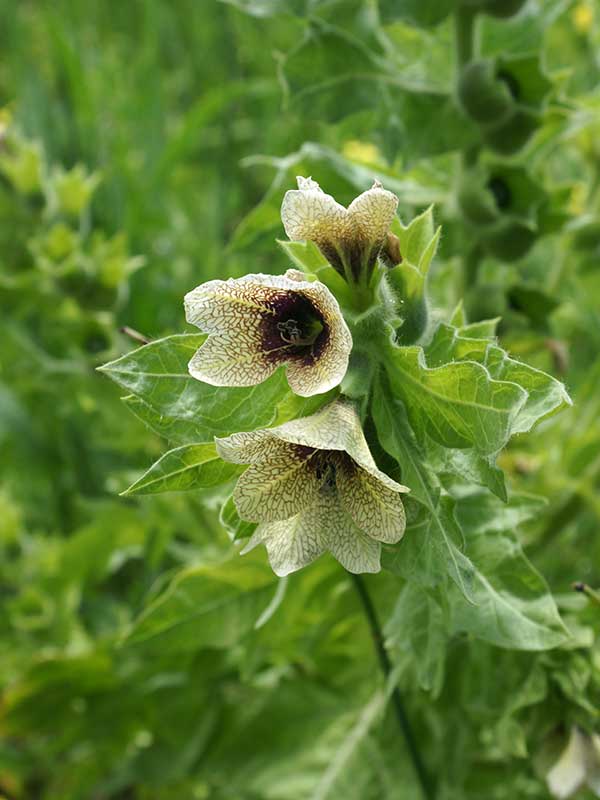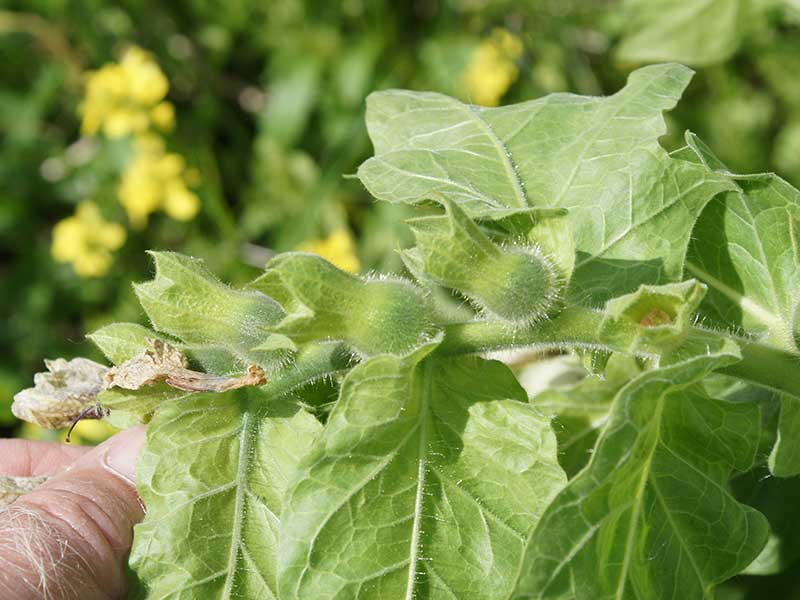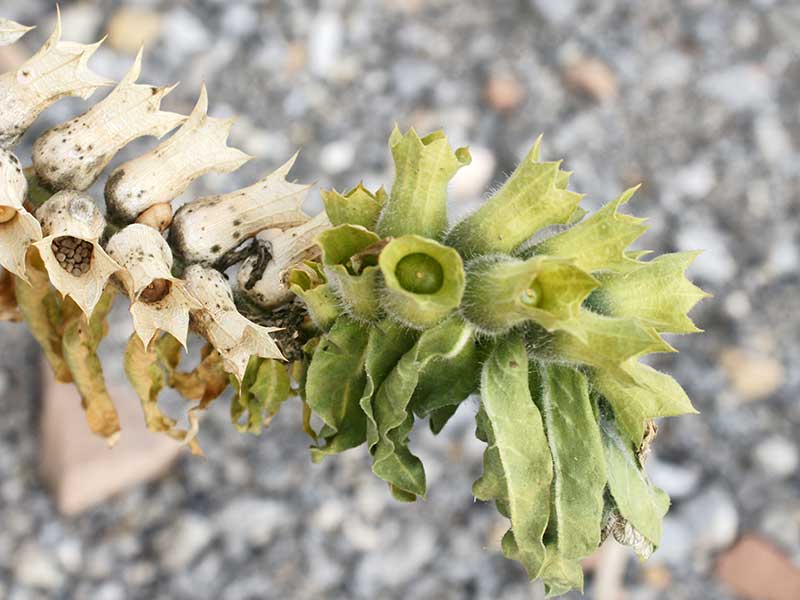Hyocyamus niger / black henbane
- highly toxic! including contact dermatitis
- 5-lobed, funnel-shaped flowers, brownish yellow with purple veins and center; 1.5″ across
- flowers in summer, e.g. warm June, July
- elliptical leaves, pointy tips, toothed or lobed margins, prominent veins
- highly disturbed areas: wastelands, field edges etc.
Also known as: henbane, stinking nightshade, hogbane, hog’s bean
Black henbane is a noxious weed, highly toxic and a relative of potato. The only reason it doesn’t kill more cattle is that it smells awful and they won’t eat it… unless it is dried and in hay, in which case they don’t notice, but it’s still toxic. With that, you’d expect a lot of the web hits to have to do with control and eradication, which they do. You’d expect it to be highly controlled, but it’s not. Indeed, you can buy seeds on Amazon (like many other noxious weeds).
Black henbane is a “long-day” plant, meaning that it flowers when the length of the day (photoperiod) is more than some threshold. Generally, that means from June onward in the Valley. It grows to as much as 5 feet tall, but in the Valley can certainly flower when much shorter – basically when it is the height of whatever canopy it has invaded.
The flowers are in one-sided clusters (racemes). They are funnel-shaped and rather than appearing to have separate petals (because they are fused at the base) they look like they have five lobes. They are up to 1.5 inches across. The distal ends of the lobes are sort of brown-ish yellow with a lovely network of purple veins. The centers of the funnels are also purple.
The leaves of black henbane are coarsely toothed. Sometimes the “teeth” are so big, they look like shallow lobes instead. They are hairy and sticky and smell awful. The leaves also have pointy tips and prominent veins.
The stems become quite tough and thick and are upright.
The fruit of black henbane is an urn-shaped capsule with many small, ca. 1.5 mm, seeds. Dried capsules are sometimes used in flower arrangements. A single plant can produce as many as half a million seeds in one season. The seeds are viable for about 4 years, normally, but at one archeological site in Germany, collected seeds germinated after 500 years. Normally, the seeds germinate either in autumn, in which case the plant overwinters as a rosette, or in early summer.
Black henbane is very cosmopolitan in its choice of habitats, but unshaded, disturbed areas are best – like plowed fields and their edges, pastures, fence rows, roadsides or waste areas. Because of its shade intolerance, however, it is not particularly good at invading established communities. It isn’t picky about temperatures or soil types, but likes hot areas and doesn’t like sodic soils (those with high pH and high concentrations of sodium carbonate). On the other hand, the same treatments that create good habitats for it also can be used to control it, i.e. plowing, disking or cultivation. Burning also works.
Interesting bit – So that’s all the boring botanical stuff. The really interesting bits about this and other noxious weeds explain things like why it showed up in North America in the first place. After all, all parts of black henbane are poisonous to both livestock and humans when ingested with symptoms like serious vomiting, impaired vision, convulsions, coma, and death from heart or respiratory failure. Oh, and it can also cause contact dermatitis – skin rashes – so wear gloves.
The earliest not-quite-fossil remains of the plant in a human-use context were collected in Germany and dated to 5090 BCE. Observations of H. niger in the eastern US date to 1672. It was imported, as seems to be the case so often, for ornamental and “medicinal” purposes. For those, it has been cultivated worldwide – roots, leaves and seeds all contain numerous alkaloids, including atropine, scopolamine and hyoscyamine. In various concoctions and decoctions, black henbane can be used as a hallucinogen, a narcotic, a psychoactive drug or in religious ceremonies. DO NOT try this at home! Messing with it is not for the feint of heart, and could lead to your being faint of heartbeat.
I must say here that the Wikipedia article on black henbane is very interesting and entertaining, and unlike the entries for other plants, has little to say about the plant itself. Another fun source is a Forest Service page on its ethnobotany. Here are some tidbits from those sources:
- the name “henbane” has nothing to do with chickens, but with an old word for death
- used as a psychoactive drug, it gives hallucinations and illusions of flying – and in that context, its use in witch’s brews. But since ingestion of these brews was problematic (because of the poison thing), they were made into ointments and applied to the skin, like the armpits or other hairy areas. Broom handles seem to be one of the applicators. Hence, witches fly and use brooms. Watch out Harry Potter. There is an interesting and readable Atlantic article about this from 2013.
- In beer making, hops have not always been available. Before hops came henbane. It seems that the German word for henbane used in brewing is Bilsenkraut. The replacement was gradual over 500 years but was sped up by the Bavarian Purity Law of 1516 which declared beer could only have barley, hops, yeast, and water. Interestingly, Bilsen was also the name of a town, later renamed Pilsen, the place of the original and best Pilsner beer.
- Hamlet’s uncle Claudius used a henbane tincture to murder Hamlet’s father (although whether it was actually henbane has been questioned).
So overall, one of the most interesting of our noxious weeds.
| Color | |
|---|---|
| Family | |
| Blossom size | |
| Inflorescence size | |
| Inflorescence type | |
| When? | |
| Where? |



